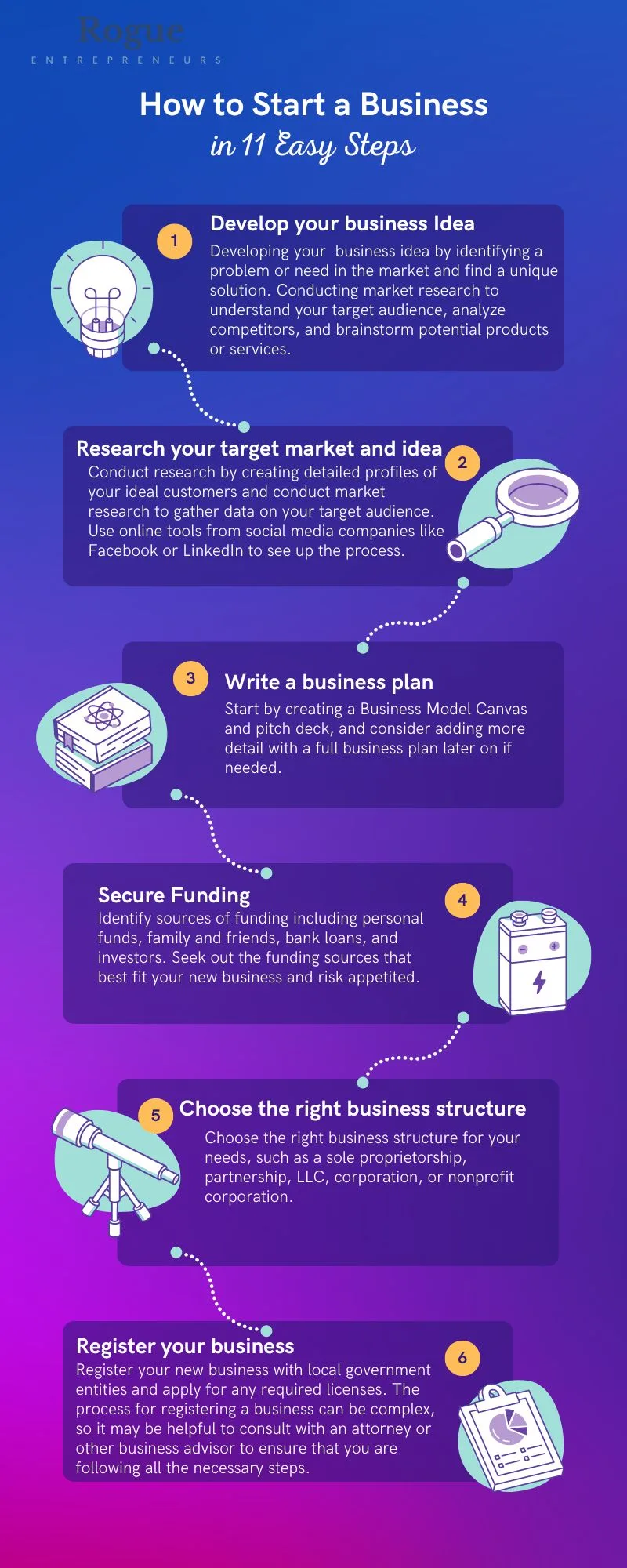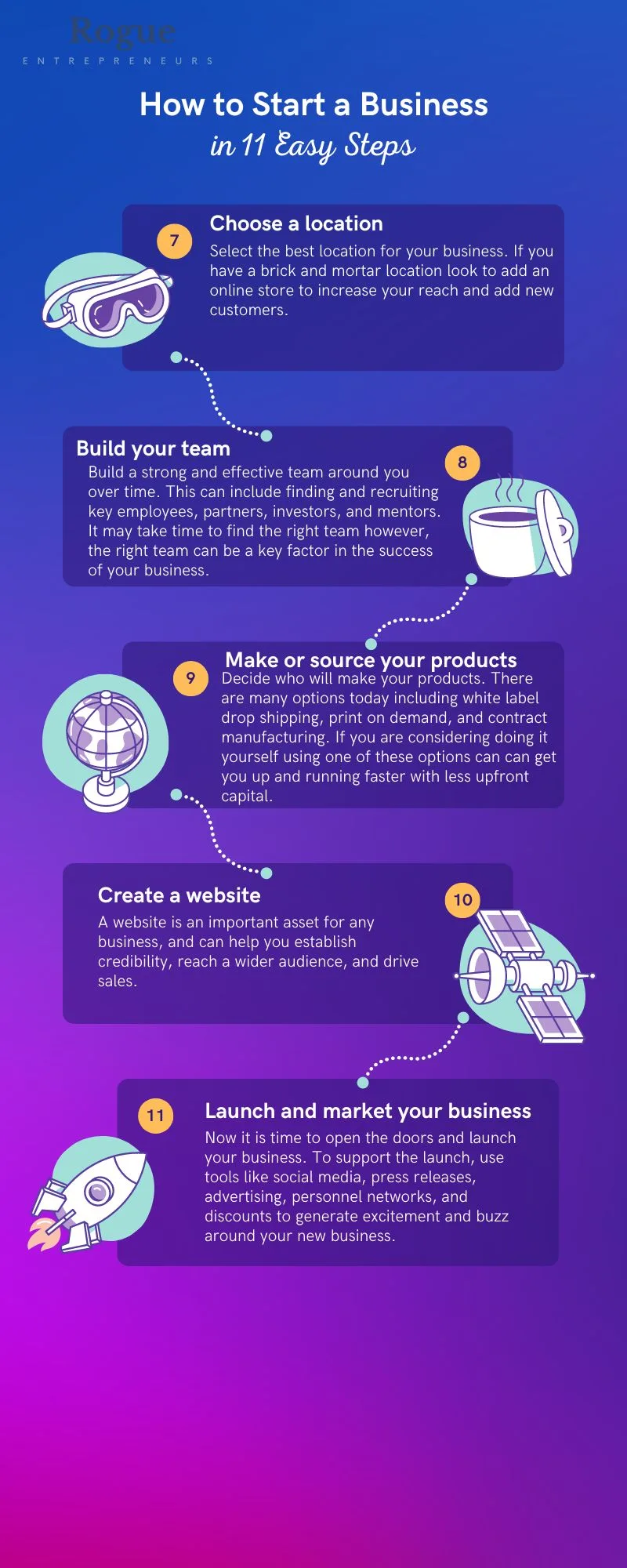How to start a business
Starting a business involves a lot of hard work, dedication, careful planning, and research to ensure that the business is viable and has a good chance of success. This guide walks you through an 11 step process of how to start a business. Starting a business includes:
- Developing a business idea.
- Creating a business plan.
- Identifying a target market.
- Finding the resources needed to get the business off the ground.
Starting a business also involves taking risks and being willing to adapt and pivot as needed in response to changing market conditions. Starting a business is a challenging and rewarding experience. Still, it is essential to be prepared and to go into it with a clear understanding of what it takes to make the business successful.
In this article, you will learn the steps needed to take you from an idea to a successful business. We’ll cover how to come up with ideas, develop a business plan, decide on the best business structure for your needs, and how to launch and to scale your business. With these tips and strategies, you’ll be on your way to turning your entrepreneurial dreams into a thriving business. Whether you’re just starting or looking to take your existing company to the next level, this article has something for you. So let’s get started!

Where to get help
If you would like to get personalized help on starting your business check out the resources on the Small Business Association’ (SBA) website.
Also, check out our post on government agencies that aid entrepreneurs.
1. Develop your business Idea
Developing a business idea starts with identifying a problem or need in the market and finding a unique solution. Creating a business idea involves:
- Conducting target audience research to understand the needs of your future customers.
- Analyzing competitors.
- Brainstorming potential products or services.
It’s essential to choose an idea that is viable and aligns with your passions and skills.
There are many places to get inspiration for identifying problems or needs in the market. Here are some suggestions:
- Talk to friends, family, and colleagues: These people can be a great source of ideas, as they may have encountered problems or needs in their own lives that you could solve.
- Conduct market research: This can involve surveying customers or researching industry trends to understand what problems or needs exist in the market.
- Read industry publications: Trade magazines, blogs, and other online resources can provide insight into what businesses in your industry currently face problems or needs.
- Attend industry events: Networking with professionals in your field and attending industry events can help you learn about current challenges and opportunities in the market.
- Observe your own experiences: Paying attention to your frustrations and needs can often lead to significant business ideas.
To start a business, you don’t need to be a famous inventor like Thomas Edison. You can build a successful business by satisfying more minor needs. For example, you may notice that people in your community have difficulty finding healthy and convenient lunch options. You could start a business that offers healthy, pre-packaged lunches that people can grab on the go. Or you’re an avid gardener, and you notice that there isn’t a local store that sells the type of seeds you like to use. You could start a business selling those seeds online or at farmer’s markets. The key is identifying a problem or need and developing a creative solution that meets that need.
It’s essential to consider the potential size of your target market when evaluating business ideas. The larger the frustration or need addressed by your product or service, the more potential customers you will have. The size of your business will likely depend on the size of your target market. So, be sure to match the scale of your idea with the scale of the business you envision.
Take your time with this step, and don’t rush. Carefully considering and thoroughly researching your business idea can save you time and money in the long run by reducing the need to pivot later on in the process. It’s common for entrepreneurs to spend months or even years developing and refining their business idea before moving forward.
Once you have a solid business idea, it’s time to start refining it by conducting market research and identifying the resources needed to bring it to life.
2. Research your target market and idea
To effectively research your business idea, it’s crucial to understand your potential customers and their needs and preferences. To do this, consider creating detailed profiles of your ideal customers and conducting market research to gather data on your target audience. For example, if you’re selling healthy snacks to vegans, research where they typically shop, their average income, and how much they usually spend on snacks. By gathering this information, you can better tailor your marketing strategy to meet your target audience’s specific needs and wants.
The goals of this research are twofold. First, you want to identify relevant themes or concepts that can be incorporated into your product and marketing strategy. Second, you want to ensure a good fit between your product and your target customers. For example, suppose you’re targeting vegans. In that case, it may be essential to highlight certifications like organic, fair trade, and ethically sourced, as these values are vital to this community and may justify a higher price point. On the other hand, a product like certified organic, fair trade, ethically sourced pork rinds would not likely appeal to a customer looking for a cheap, salty snack.
Where can you do target market research?
Social media platforms: Many businesses have a presence on social media, which can be a rich source of customer information. For example, you can use Facebook’s Audience Insights tool to learn more about your followers’ demographics, interests, and behaviors.
Customer feedback and review sites like Yelp, Trustpilot, and G2 Crowd allow customers to rate and review products and services. Reading through these reviews can better understand what customers like and dislike about a business and their products.
Industry-specific forums and discussion groups: Consider joining industry-specific forums and discussion groups, which can be found online and offer a place for like-minded professionals to discuss challenges and share knowledge about a particular industry or niche. These groups can provide valuable insight into the needs and frustrations of your target customers. For example, Reddit has numerous subgroups that cover a wide range of topics, and people often share their complaints and unmet needs in these forums. Participating in these discussions allows you to learn more about your potential customer’s needs and pain points.
Market research reports: Many market research firms publish reports on various industries. These reports can provide valuable insights into customer demographics, buying habits, and more.
How do you research your business idea?
When starting your research efforts, it’s essential to research your competition and assess the potential demand for your product or service. Look for gaps in the market that your business could fill and gather feedback from potential customers through surveys or focus groups. Business idea research will help you validate your concept and identify the features and benefits that are most valued by your target audience.
Additionally, research the costs involved in launching and operating your business, including production costs, marketing expenses, and overhead. Business idea research will help you create a financial plan and determine the feasibility of your idea.
Consider seeking guidance and support from industry experts or joining an accelerator program or business incubator. And remember to keep an open mind and be willing to pivot or adjust your business idea based on your research findings.
It’s important to start small and scale your business idea gradually to avoid unnecessary risk and expenses. For example, if you want to sell cookies based on your grandmother’s famous recipe, take your time renting a commercial kitchen and buying large quantities of ingredients before you’ve sold your first batch of cookies. Start by making a small batch and pricing them based on your expected production costs, then sell them yourself and gather customer feedback. This real-time research will help you gauge the potential success of your idea and make adjustments if necessary.
3. Write a business plan.
Start by completing the Business Model Canvas, a strategic management tool that will help you fully describe and design your business model. It provides a visual representation of the critical elements of a business and how they relate to each other. The Business Model Canvas consists of nine building blocks representing a company’s value proposition, customer segments, channels, customer relationships, revenue streams, resources, activities, partners, and cost structure. The tool helps entrepreneurs to understand and analyze the various components of their business model, identify potential improvements, and develop strategies for growth and success.
The Business Model Canvas is a streamlined tool that allows you to see the critical elements of your business on a single page. Focusing on the essential information can eliminate unnecessary details and save time if you need to pivot or adjust your strategy. It’s necessary to take your time and get this stage right, as it can save you significant time and effort in the future.
Develop a pitch deck
A pitch deck is a presentation used to communicate the critical elements of a business plan to potential investors or partners. It typically consists of 10-15 slides that outline the key elements of a business plan, such as the problem the business is solving, the solution it offers, the target market, the competitive landscape, the business model, the marketing and sales strategy, the team, the financial projections, and the ask (i.e., the amount of funding or resources being requested).
Entrepreneurs use pitch decks to persuade potential investors or partners to invest in or support their businesses. They are often used in conjunction with a verbal pitch or presentation. Still, they can also be used as a standalone document to communicate the critical points of a business plan clearly and concisely.
Pitch decks are an essential tool for entrepreneurs seeking funding or support for their businesses, as they help convey the value and potential of the business in a compelling and visually appealing way.
Expand on your idea by writing the business plan
A business plan is a document that outlines the critical elements of your business, including your business model, marketing and sales strategy, financial projections, and operational plan. It serves as a roadmap for the development and growth of your business and is often used to secure funding from investors or lenders.
Using your Business Model Canvas and pitch deck as a starting point, you can expand upon your business idea and add additional context or data to support your plan. The business plan can include information about your target market, competitive landscape, marketing and sales efforts, financial projections, and critical milestones.
A well-written business plan is essential for communicating the value and potential of your business to potential investors or partners. It can help you secure the funding you need to bring your business idea to life and achieve your long-term goals.
4. Secure funding
It is vital to ensure that a new business is properly funded because having sufficient funding can help the business get off the ground and support its operations and growth. With adequate funding, a business may be able to cover its costs and may be able to invest in the resources, such as marketing and staff, needed to grow and succeed. Additionally, a solid financial foundation can help a business weather unexpected challenges or setbacks and provide a cushion for times of slow sales or economic downturn. Proper funding can also help a business attract top talent and build credibility with partners and investors.
There are several ways to secure funding for a new business:
- Self-funding includes using personal savings, credit cards, or loans from family and friends to finance the business.
- Crowdfunding involves using platforms like Kickstarter or Indiegogo to raise small amounts of money from a large number of people, often in exchange for a reward or equity in the business.
- Angel investors: These are high-net-worth individuals who provide capital in exchange for equity in the business.
- Venture capital: This funding is provided by firms or investors to high-growth startups in exchange for equity.
- Bank loans are loans from banks or other financial institutions that can be used to finance the business.
- Grants: These are funds provided by governments, foundations, or other organizations to support the development of new businesses.
- Incubators and accelerators: These programs provide funding, mentorship, and other resources to help businesses get off the ground.
- Partnerships involve partnering with another company or individual to fund and grow the business jointly.
It’s important to consider all the pros and cons of each funding option and choose the one that best meets the needs of your business.
5. Choose a business structure.
Each business structure has advantages and disadvantages, and the right one for your business depends on your specific needs and goals. Some common business structures include sole proprietorship, partnership, limited liability company (LLC), corporation, and nonprofit corporation. When choosing a business structure, you must consider the level of personal liability you are comfortable with, the amount of control you want over the business, and your long-term goals. It’s essential to consider each option’s pros and cons and consult with an attorney or financial advisor to determine the best fit for your business.
| Business Structure | Pros | Cons |
| Sole Proprietorship | Simple and inexpensive to set up | Unlimited personal liability |
| Partnership | Simple and inexpensive to set up | Unlimited personal liability |
| Limited Liability Company (LLC) | Personal liability protection | More expensive and complex to set up and operate compared to sole proprietorships or partnerships |
| Corporation | Personal liability protection | More expensive and complex to set up and operate compared to sole proprietorships or partnerships |
| Nonprofit Corporation | Exempt from federal income tax | Limited to activities that benefit the public |
6. Register your business
The process for registering a business varies depending on the type of business and the location in which it is based. Here are the general steps for registering a business:
- Choose a business structure: Decide on the type of business structure best suited to your needs, such as a sole proprietorship, partnership, LLC, or corporation.
- Choose a business name: Choose a unique and memorable name for your business and ensure it is available. You may need to conduct a trademark search to ensure that another business does not already use the name. Also, consider what domain names are available when choosing a name.
- Register with the state: Most businesses need to register with the state where they are located. State Registration typically involves filing articles of incorporation or a similar document with the state government.
- Obtain any necessary licenses and permits: Based on your starting business, you may need to obtain licenses and permits to operate legally. These may include licenses related to your business location, industry, or the products or services you are offering.
- Register for taxes: Most businesses need to register for various taxes, such as sales tax, income tax, and payroll tax. Tax registration typically involves obtaining an Employer Identification Number (EIN) from the Internal Revenue Service (IRS).
- Set up a record-keeping system: It’s essential to establish a system for keeping track of your financial records and other critical business documents. Record keeping will help you stay organized and make filing tax returns and other required paperwork easier.
Registering a business can be complex, so consulting with an attorney or other business advisor may be helpful to ensure that you are following all the necessary steps.

Choose a location
The type of business you are starting, your target market, and your budget. Here are some factors to consider when selecting a location for your new business:
Type of business: The type of business you are starting will determine the most suitable location. For example, a retail business will likely need a brick-and-mortar location. In contrast, a service-based business or online business may be able to operate from a home office or virtual location.
Target market: Consider where your target market is located and choose a location that is convenient and accessible to them.
Budget: The cost of leasing or purchasing a location will be essential to your decision. Consider your financial resources and choose a location that fits within your budget.
Competitors: Take a look at the competition and consider how their location may impact your business.
Demographics: Consider the demographics of the area where you are considering locating your business.
Access to resources: Consider the area’s availability of transportation, utilities, and skilled labor.
Selecting the right location for your new business requires careful consideration of these and other factors. It’s essential to take the time to research and evaluate your options before making a decision.
Build your team
Building a team for a new business is essential to its development and success. Here are some tips for creating a team:
Identify your needs: Consider what skills and expertise are necessary for your business to succeed and look for team members who can fill those gaps.
Define roles and responsibilities for your team: Clearly define the roles and responsibilities of each team member to ensure that everyone knows what is expected of them.
Look for diversity: Consider diversity in terms of skills, backgrounds, and perspectives when building your team. A diverse team can bring a wide range of perspectives and concepts to the table, which can be beneficial for problem-solving and decision-making.
Evaluate potential team members: Carefully evaluate the qualifications and fit of potential team members to ensure that they are the right fit for your business.
Offer competitive compensation: It’s vital to offer competitive compensation packages that include salary and benefits when attracting top talent.
Foster a positive culture: Create a positive and supportive work environment to encourage teamwork and collaboration.
Communicate and delegate effectively: Communicate expectations and delegate tasks appropriately to ensure your team works efficiently and effectively.
Building a solid and effective team is an ongoing process, and finding the right fit may take time and effort. However, the right team can be a critical factor in the success of your business.
Make or source your products.
The way you source your products will depend on the business you are forming. While it may be easier and more cost-effective to sell products made by others, there are several options to consider, including:
Buy and sell: This involves purchasing products from a supplier or manufacturer and reselling them to customers.
Print on demand: This model involves creating custom products, such as mouse pads, t-shirts, or mugs, using a print-on-demand service. Customers place orders, and the products are produced and shipped directly to them.
Dropshipping involves partnering with a supplier or manufacturer and listing their products for sale on your website. The supplier ships the product directly to the customer when an order is placed.
Make it yourself: This model involves creating and producing products by hand or using machinery.
Contract manufacturing: This involves outsourcing the production of your products to a third-party manufacturer.
White labeling involves purchasing products from a manufacturer and then rebranding and reselling them under your brand.
Each option has its own pros and cons, and the right one for your business will depend on your specific needs and goals. It’s important to carefully evaluate the options and choose the best fit for your business.
Are you enjoying this article on How to start a business?
If so, check out these related articles:
Entrepreneur Movies: 8 movies that inspire
What entrepreneurs do on a daily basis
Do this before becoming an entrepreneur
Create a website
A website is an essential asset for any business and can help you establish credibility, reach a wider audience, and drive sales.
Having a website for your new business is essential for several reasons:
Credibility: In today’s digital age, consumers expect businesses to have an online presence. A website can establish credibility and professionalism for your business.
Accessibility: A website makes it easy for customers to find and learn about your business, regardless of where they are located.
Marketing and advertising: A website can be an effective marketing and advertising tool, helping you reach a global audience and attract new customers.
E-commerce: A website is essential if you sell products or services online. It allows you to process transactions efficiently and reach a global customer base.
Customer service: A website can provide a convenient way for customers to learn about your products or services, ask questions, and get support.
Launch and market your business
You can use many strategies to launch and market your new business. It’s essential to identify the most effective tactics for your business and allocate your resources accordingly.
Here are some tips for launching and marketing a new business:
Utilize social media: Social media platforms like Twitter, Facebook, and Instagram can be powerful tools for promoting your business and engaging with potential customers.
Create a newsletter: A newsletter is a great way to keep in touch with your customers and keep them informed about your business.
Network and make connections: Attend industry events and network with other professionals in your field. Building relationships with potential customers and partners can be an effective way to promote your business.
Offer promotions and discounts: Offering promotions and discounts can be an excellent way to attract new customers and encourage them to try your products or services.
Seek press coverage: Getting media coverage for your business can be a powerful way to increase visibility and credibility. Consider reaching out to local media outlets or industry publications to pitch your story.
Next Steps for How to start a business
Follow these next steps to grow your business after a successful launch.
Build brand awareness
Building brand awareness for a new company takes time and effort, but a strategic and consistent marketing plan can help you reach your target audience and establish your brand in the marketplace.
There are several ways to build brand awareness for a new company:
Develop a strong brand identity: A strong brand identity includes elements such as a logo, color scheme, and messaging that reflect the values and personality of your business.
Utilize content marketing: Content marketing is creating and sharing valuable, relevant, and consistent content. Content marketing has the goal of attracting and retaining a clearly defined audience. Content marketing can include blog posts, articles, videos, podcasts, and other types of content.
Collaborate with influencers: Building partnerships with influencers with a large following can effectively reach new audiences and build brand awareness.
Attend industry events: Attending industry events and conferences can be an excellent way to network with other professionals and increase visibility for your business.
Utilize public relations: Working with a public relations (PR) firm or in-house PR team can help secure media coverage and increase awareness for your business.
Scale your business
Scaling a new business requires careful planning and a focus on sustainability and efficiency. It’s important to carefully evaluate your resources and capabilities and scale at a manageable and sustainable pace.
Scaling a new business involves growing the business in a way that is sustainable and efficient. Here are some tips for scaling a new business:
Invest in infrastructure: As your business grows, it’s crucial to invest in the infrastructure required to support this growth, such as hiring additional staff, upgrading systems and equipment, and expanding your physical space.
Automated processes can help you scale more efficiently and save time and resources.
Diversify your revenue streams: Diversifying your revenue streams can help you mitigate risk and ensure the stability of your business.
Seek funding: If necessary, consider seeking additional funding to support your growth. Funding can include funding from investors, loans, or grants.
Foster a continuous improvement culture: Encourage continuous improvement within your business and continually optimize processes and systems.
Conclusion: How to start a business.
Starting a business is a challenging yet fulfilling journey that requires careful planning and research to increase the chances of success. To help guide you through the process, we’ve compiled a list of 11 steps that cover the planning, research, and execution phase of starting a new business. These steps, based on various resources describing how to start a business, provide a roadmap to help you navigate the process and turn your business dream into a reality.
- Identify one problem or need in the market and develop unique solutions.
- Research your business idea by understanding your potential customer’s needs and preferences.
- Write a business plan using a Business Model Canvas and pitch deck, and consider adding more detail with a complete business plan if needed.
- Ensure that you have sufficient funds to operate by securing funding for your new business.
- Choose the proper business structure for your needs, such as a sole proprietorship, partnership, LLC, corporation, or nonprofit corporation.
- Register your business, possibly with the help of an attorney or business advisor.
- Select the best location for your business, considering accessibility, cost, and potential customer base.
- Build a solid and effective team to support your business.
- Determine how to make or source your products, considering manufacturing, wholesale, or drop shipping options.
- Create a professional website to establish credibility, reach a wider audience, and drive sales.
- Launch and market your business using the most effective strategies for your needs.
With these steps in mind, you can embark on your entrepreneurial journey and bring your business idea to life. Good luck!”
Question
Once you start a new business, what will you be doing all day? Check out this post to find out.






